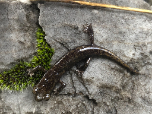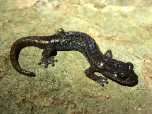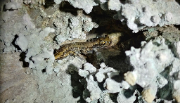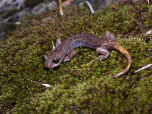Wintu Shasta Salamander (Hydromantes wintu)
Description: Adults measure 1 3/4 to 2 1/2 inches long from snout to vent length, and from 3 to 4 1/3 inches in total length. A small stocky salamander with a short tail, webbed feet, a flattened body, and a very long mushroom-like tongue capable of extending out up to 2.4 inches from the front of the mouth. 13 costal grooves, and nasolabial grooves.
Not as adapted for crack dwelling as other Hydromantes species with less toe webbing and the body is not as flattened. Dark reddish brown above, mottled with grayish green to tan specks, with some yellow on the tail. Venter is grayish.
Habitat: Its distribution was likely fragmented by the creation of the lake and the construction of the Shasta Dam. Proposals to raise the water levels of the lake would likely flood more habitats and further threaten it. However, in 2021 the U.S. Fish and Wildlife Service found the species to not warrant Endangered Species Act protections.
Range: It is found in a very small area on the McCloud River arm on the north shore of Shasta Lake, near the vicinity of the former Shasta Iron Mine.
Found in these States:
CA
Diet: Probably feeds on insects and other small invertebrates.
Reproduction: Little is known about the breeding behavior of this species. Reproduction is terrestrial. Females apparently lay eggs in moist limestone shelters in late summer and brood them until they hatch in late fall. They would have hatched in late October or early November. Young develop completely in the egg and hatch fully formed.
Status: This species has a very restricted range with an extent of occurrence of 28 km2. It occurs in a relatively remote area, and its population is believed to be stable at present, however there is a current proposal to raise the Shasta Dam and the associated construction could present a future threat to this species. In addition, climate change is an increasing threat in this region that could result in decline in the quality of habitat in the future. Lastly, if disease (Bsal) was introduced within its range it could have severe consequences for the population. All of these future threats have the potential to drive this species to Critically Endangered or Extinct in a very short period of time hence this species is currently listed as Vulnerable under criterion D2.
Taxonomy: It was previously thought to be a population of the Shasta salamander (H. shastae) and is not physically distinguishable, but a 2018 phylogenetic study found it to be a genetically distinct species. It is named in honor of the Winnemem Wintu people who originally inhabited the area until being displaced by early European settlers, and had many of their cultural sites inundated by Shasta Lake.
»» Kingdom: Animalia - Animals
»» Phylum: Chordata - Chordates
»» Subphylum: Vertebrata - Vertebrates
»» Class: Amphibia - (Amphibians)
»» Order: Caudata - Salamanders
»» Family: Plethodontidae - Lungless Salamanders
»» Genus: Hydromantes
»» Species: Hydromantes wintu - Wintu Shasta Salamander
This article uses material from the Wikipedia article "Wintu Shasta Salamander", which is released under the Creative Commons Attribution-Share-Alike License 3.0. Content may have been omitted from the original, but no content has been changed or extended.
|












